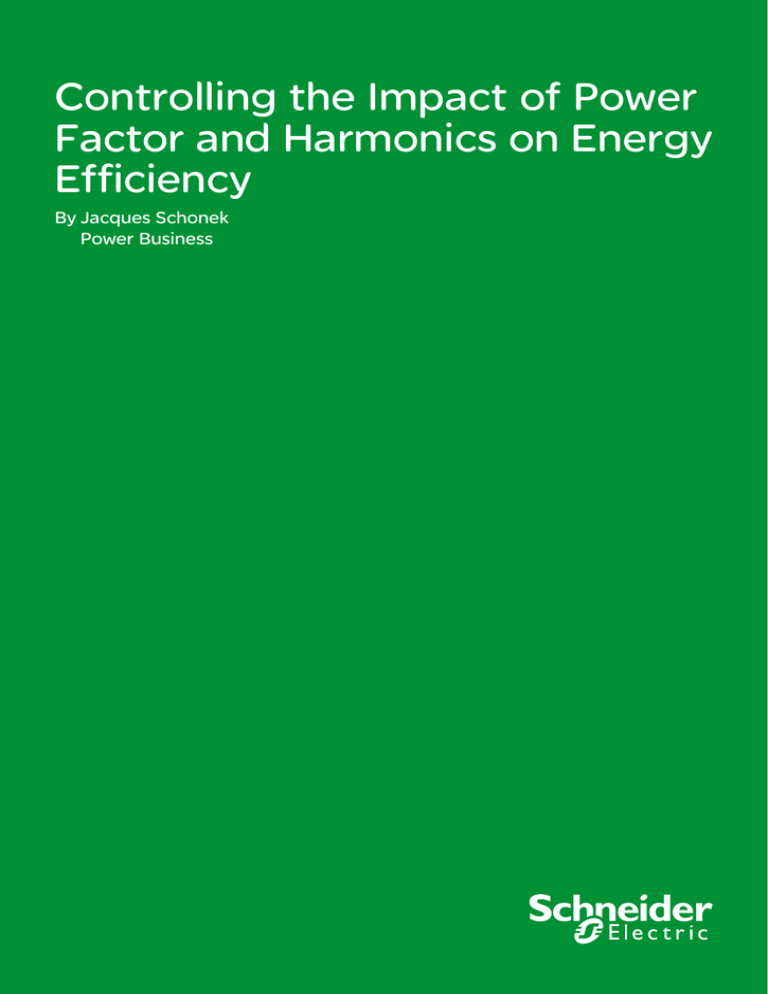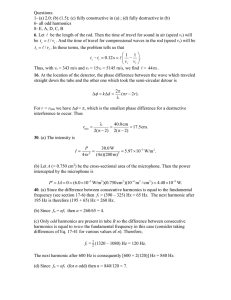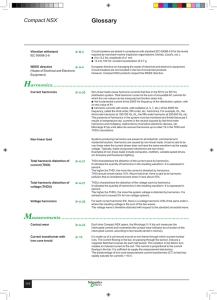
Controlling the Impact of Power
Factor and Harmonics on Energy
Efficiency
ByJacques Schonek
Power Business
Summary
Executive Summary...................................................................................... p 1
Introduction.................................................................................................. p 2
Identifying and analyzing problem areas........................................................ p 4
Harmonic mitigation and PFC solutions........................................................ p 5
Designing for energy efficiency..................................................................... p 7
Harmonic mitigation of Variable Speed Drives (VSD)..................................... p 8
Conclusion................................................................................................... p 9
Controlling the Impact of Power Factor and Harmonics on Energy Efficiency
Executive summary
A Power Factor Correction (PFC) and harmonics mitigation plan will always
improve the energy efficiency of electrical installations. Much like bumps and
holes in a road impede the progress of an automobile, distorted voltage in AC
distribution systems negatively impacts operations and drives up expenses.
This paper analyzes PFC and harmonics problem areas and offers practical
approaches for improvements.
COM-POWER-WP02EN Rev1 | Controlling the Impact of Power Factor and Harmonics on Energy Efficiency
Introduction
Design engineers and facility managers are now required to pay more
attention to saving energy and improving the availability of clean electricity at
their work sites. This paper is written to assist electrical installation designers
in identifying out-of-phase and voltage distortion problem areas. In addition,
various harmonics mitigation and PFC solutions are discussed. The goal is
to leverage existing and new technologies to decrease OPEX and to improve
energy efficiency within the site’s power infrastructure.
COM-POWER-WP02EN Rev1 | Controlling the Impact of Power Factor
and Harmonics on Energy Efficiency
Controlling the Impact of Power Factor and Harmonics on Energy Efficiency
Identifying and analyzing problem areas
In AC distribution systems, the maximum active
For illustration, Figure 1 presents voltage and
power is transmitted to a load when voltage and
current wave forms for different situations, but
current are in phase and undistorted.
with the same active power P transmitted to the
load. With DPF = 0.7 or THDi = 100 %, the r.m.s.
When voltage and current are phase-shifted, the
current is increased by more than 40 % for the
instantaneous power P = V x I is negative when
same active power.
the signal signs are opposite. The average power
is then reduced compared to the situation where
As the power losses in the circuits are proportional
the signals are in phase. The relevant parameter is
to the square of the r.m.s. current, the power
the Displacement Power Factor (DPF) which is the
losses in the two non-ideal situations are doubled.
cosine of the phase angle j between voltage and
These additional power losses mean more CO2
current (cos j).
emission, premature ageing, higher electricity cost,
and higher equipment cost.
When a current is distorted, the instantaneous
power fluctuates significantly. The average power
Another major consequence of harmonics is
is then reduced compared to a situation where
the deterioration of the supply voltage quality.
the current is undistorted. The current distortion
The circulation of harmonic currents through the
means that harmonics are present, generated by
system impedance creates voltage harmonics
non-linear loads. The Total Harmonic Distortion
resulting in voltage distortion. The negative impact
(THD) is the usual parameter to evaluate the
may remain un-noticed, with adverse economic
distortion of current (THDi) or voltage (THDu).
results.
Therefore, low DPF and harmonics mean that the
power transfer to the load is not maximized for a
Power Factor Correction and proper harmonic
given value of r.m.s. (root-mean-square) current. In
mitigation can contribute to improved operations
other words, the current circulating in the electrical
within companies in several ways:
circuits is higher than what is strictly necessary for
•
transmitting the active power to the machines.
The Power Factor (PF) has been introduced to
assess this phenomenon.
reduced overloading on the electrical system
thereby releasing useable capacity
•
•
•
reduced system losses and demand power
reduced risks of outage
extended equipment lifetime.
Figure 1
I
V
Sample situations impacting
power factor.
DPF = 1
THDi= 0
PF = 1
Irms= I
V
DPF ≈1
THDi= 100%
PF = 0.71
Irms= 1.41 x I
I
V
I
DPF = 0.7
THDi= 0
PF = 0.7
Irms= 1.43 x I
COM-POWER-WP02EN Rev1 | Controlling the Impact of Power Factor and Harmonics on Energy Efficiency
Harmonic mitigation and PFC solutions
Numerous approaches can be deployed to
address harmonics and power factor issues in a
facility. The following section illustrates some of the
main categories of options.
Capacitor banks
Capacitor banks (see Figure 2) improve Power
Factor Correction and help to avoid reactive
Gh/Sn
energy penalties charged by the utility. Capacitor
bank equipment may be connected at the
following levels of the facility’s power infrastructure
<15%
15 to 25%
25 to 50%
>50%
rated
Classic
Comfort
overrated
detuned
Harmony
Filters
installation: medium voltage (MV) substation, low
voltage (LV) main switchboard, LV secondary
switchboard, and machine terminals.
Figure 3 – Selection criteria.
The following points should be considered when
selecting capacitors:
Overrated capacitors must be selected when
Gh/Sn exceeds 15 % because harmonic currents
will be responsible for increased stress.
When Gh/Sn exceeds 25 %, a series reactor
is necessary to protect the capacitors against
harmonic currents. This is called a detuned reactor
because capacitors and the reactor are set up in
a resonant circuit configuration, not tuned to the
frequency of any harmonic order.
Figure 2 – Example of low voltage capacitor banks.
Passive filters are implemented when Power
When capacitor banks are installed in the presence
Factor Correction is requested with a high level of
of harmonics, two parameters shall be considered:
existing harmonic distortion. These filters consist of
Gh: total power of the non-linear loads,
reactors and capacitors set up in a resonant circuit
Sn: rated power of the supply transformer.
configuration, and are tuned to the frequency of
the harmonic order to be eliminated. A system may
Different types of equipment must be selected
be composed of a number of filters to eliminate
depending on the level of the network harmonic
several harmonic orders.
emission. The selection is based on the value of
the Gh/Sn ratio, as illustrated in Figure 3:
Active filters
Active filters are systems employing power
The active filter injects, in opposite phase, the
electronics which provide the harmonic currents
harmonics drawn by the load, such that the line
required by nonlinear loads thereby avoiding
current remains sinusoidal.
distortion on the power system.
COM-POWER-WP02EN Rev1 | Controlling the Impact of Power Factor and Harmonics on Energy Efficiency
Hybrid filters
Hybrid filters are systems that include a passive
filter and an active filter in a single unit. They
combine the advantages of both technologies and
provide an optimum cost / performance ratio.
Figure 4 - Examples of active and hybrid filters.
Electronic compensators
Active or hybrid filters are also capable of
In this mode of operation, they are also known as
compensating for low values or fluctuations of the
"Static Var Compensators" (SVC) or "Hybrid Var
Displacement Power Factor.
Compensators" (HVC).
Solutions that support Variable Speed Drives (VFD)
AC-Line or DC-link chokes are commonly used
winding transformer providing a 12-pulse supply
with drives up to about 500kW unit power. When
for the drive is considered standard. This limits the
a large number of drives are present within an
harmonic emission and, in most cases, no further
installation, the use of AC-Line or DC-link chokes
mitigation is necessary. Multi-pulse solutions are
for each individual drive is recommended. This
the most efficient in terms of power losses and
measure increases the lifetime of the drives and
compliance to standards is simplified.
enables use of cost effective mitigation solutions,
3-winding
transformer
such as active filters, for example, at the time of
installation (see Figure 5).
Mains
C-less technology applies to Variable Speed Drives
and offers a reduced current distortion compared
to traditional technology. Combined with an
advanced control algorithm, this solution is suitable
for applications with low over-torque requirements
like centrifugal pumps, fans and HVAC machines.
DC-line
choke
Mains
AC-line
choke
Figure 6 - Multi-pulse arrangement.
An Active Front End (AFE) is the best performing
solution concerning harmonic mitigation with
drives, limiting the THDi below 5 % (see Figure 7).
All the applicable standard requirements can be
met. No detailed system evaluation is necessary,
making this solution the easiest to implement. In
addition to harmonic mitigation, power regeneration
and power factor correction are inherent.
Line-filter
Figure 5 – Chokes for drives.
A multi-pulse arrangement is often used for drives
Mains
above 400 kW, but could also be a reasonable
solution for smaller power ratings (see Figure 6).
A precondition is a dedicated transformer directly
Figure 7 - Active Front End configuration.
supplied from the MV network. The use of a 3-
COM-POWER-WP02EN Rev1 | Controlling the Impact of Power Factor and Harmonics on Energy Efficiency
Designing for energy efficiency
In the domain of electrical installations, energy
PFC and harmonic mitigation impacts all 3 aspects
efficiency is defined as follows:
of energy efficiency in the following ways:
•
•
energy savings: reduction in energy
Reduction of the power losses in transformers,
consumption
cables, switchgear, motors, capacitors
•
•
energy cost optimization: reduction in the cost of
Reduction of the demand power (in MVA),
energy paid to the utility
resulting in lower electrical bills
•
•
availability and reliability: reduction in the risk of
outage, and efficient equipment operation.
Optimization of total system capacity, without
risk of overload, nuisance tripping or premature
ageing of equipment.
Parameters to be considered
In order to better manage harmonics, the following
Project drivers
parameters should be considered:
Whenever an investment is necessary, it is
important to set a priority concerning the project
Network parameters
drivers. A solution optimized for a low Capex may
It is important to understand the characteristics
result in higher Opex and vice versa. Performance
of the power network in order to be able to
specifications for a solution will also impact both
accommodate conditions at the Point of Common
Capex and Opex.
Coupling (PCC)–this is the point where the
installation is connected to the utility network, and
Applicable reactive energy penalties
where other utility customers may be connected.
The contractual arrangements with energy
The system size (known by power or impedance)
suppliers can also influence the design of the
and topology both have an influence on the
installation. If penalties for exceeding reactive
resulting harmonic distortion.
energy limits are in place, the implementation
of Power Factor Correction capacitors should
Industry
be considered. However, if harmonic current
Applicable standards vary depending upon the
generators and capacitor banks are present,
environmental characteristics of industry specific
current and voltage distortions may be amplified
facilities. Relevant standards in residential,
(resonance phenomenon). This has a significant
commercial or light industry sectors are generally
impact on the resulting harmonic distortion. Thus,
applicable to pieces of equipment. Standards in
a simultaneous review of both PFC and harmonic
heavy industry sectors, on the other hand, are
mitigation should be considered and additional
applicable to global installations and not at the
precautionary measures may need to be taken.
individual component level. Thus, central mitigation
is generally more cost effective in heavy industry
Ratio of non-linear load power to total load
sectors.
power
The higher the share of non-linear loads compared
Applicable harmonic standard
to the total load power of an installation, the higher
Once industry and network parameters are
the necessity for evaluation of harmonics.
determined, the applicable standards should be
enforced. Exceeding the standard requirements,
however, will result in a higher investment than
is needed. On the other hand, application of
excessively relaxed standards can result in
higher energy and maintenance costs, as well as
disturbances on the mains.
COM-POWER-WP02EN Rev1 | Controlling the Impact of Power Factor and Harmonics on Energy Efficiency
Harmonic mitigation of Variable Speed
Drives (VSD)
The installation of Variable Speed Drives (see
•
Figure 8) should take into account the following
as no significant reactive energy is requested
considerations:
anymore by the VSD driven motor
•
•
if the motor driven by the VSD is newly installed,
the Power Factor Correction has to be revised,
the impact of harmonics has to be analysed,
the availability of power from the supply system
both in terms of possible disturbances and
should be checked
compliance to standards.
Figure 9
Variable Speed Drives in a
pumping station
Steps for deploying a solution
The evaluation and selection of a suitable
3. Check impact on existing equipment of
harmonics mitigation solution should include the
installation
following three steps:
When a new non-linear load is connected to
1. Select the relevant harmonic emission limit
an existing installation, it has to be determined
(equipment or installation standard)
if it influences the other components already
This step identifies the applicable standards. The
connected on the same network. This is relevant
standards can apply to specific equipment or to
for capacitors and active filters in particular. Below
a global installation. As the limits applicable at
are some examples of common scenarios:
the installation level are generally more restrictive,
•
applying these limits at the equipment level is not
installation (Power Factor Correction or passive
cost effective.
harmonic filter), there is a risk of overload and
if capacitors are already present in the
resonance introduced by the additional harmonic
2. If harmonic mitigation is needed or
currents. Usually the supplier of the PFC or passive
advisable, consider equipment mitigation first
filter is able to evaluate the situation and should be
For drives totalling a power load of up to 100 kW:
contacted first.
•
this power usually represents less than ~20 % of
•
if passive or hybrid filters are present, the
the transformer rated power. The standard solution
installed filter can be kept unchanged if it is
is to use AC-Line or DC-link chokes.
oversized and can match the new current
For total drives power from about 100 kW up to
requirements. Otherwise, the passive element
about 1,000 kW:
must be redesigned, as it is not possible to
•
in this power range, it is advisable to have the
connect another element in parallel with exactly the
transformer power equal to at least 2.5 times the
same frequency tuning.
drives load. The standard solution is to use AC-
•
Line or DC-link chokes.
must always be equipped with line chokes. This
For drives whose power load ranges from 100 kW
will significantly reduce the harmonic current
to 1,000 kW:
emission and thus the necessary current rating
•
in this power range, drives are usually equipped
if an active filter is present, non-linear loads
of the active filter. No risk is introduced by the
with a dedicated transformer directly supplied
additional harmonic currents as the active filters
from the MV network. A 3-winding transformer is
are usually protected against overload. However,
commonly used, providing a 12-pulse supply for
the cancellation of harmonic currents may not be
the drives. This limits the harmonic emission and,
totally effective, and the global performance may
in most cases, no further mitigation is necessary. In
be deteriorated. Usually the network designer
addition, multi pulse solutions are the most efficient
is able to evaluate the situation and should be
in terms of power losses. This allows for easy
contacted first.
compliance to the most stringent standards.
COM-POWER-WP02EN Rev1 | Controlling the Impact of Power Factor and Harmonics on Energy Efficiency
Conclusion
Power Factor and harmonics, because of their
impact on energy efficiency, are important issues
to consider for the management of electrical
installations. Multiple approaches are analyzed
and explained so that performance of electrical
systems can be optimized.
Solutions for Power Factor Correction and
harmonic mitigation have been presented in a
practical way, answering basic questions frequently
asked by electrical installation designers.
Power Factor Correction and harmonics mitigation
both provide immediate benefits in terms of
reduced power losses and reduced electricity
bills. In addition, both of these best practices
encourage the use of total system capacity in
electrical installations thereby increasing payback
on investment.
COM-POWER-WP02EN Rev1 | 35, rue Joseph Monier
CS 30323
F- 92506 Rueil Malmaison Cedex
RCS Nanterre 954 503 439
Capital social 896 313 776 €
www.schneider-electric.com
COM-POWER-WP02EN
This document has been
printed on ecological paper
09-2009
© ������������������������������������������������
2009 - Schneider Electric - All rights reserved.
Schneider Electric Industries SAS





